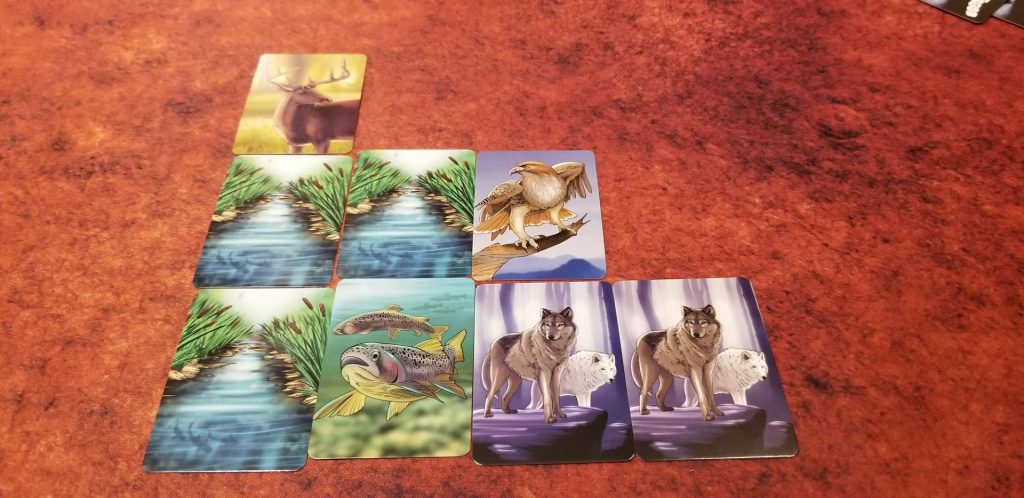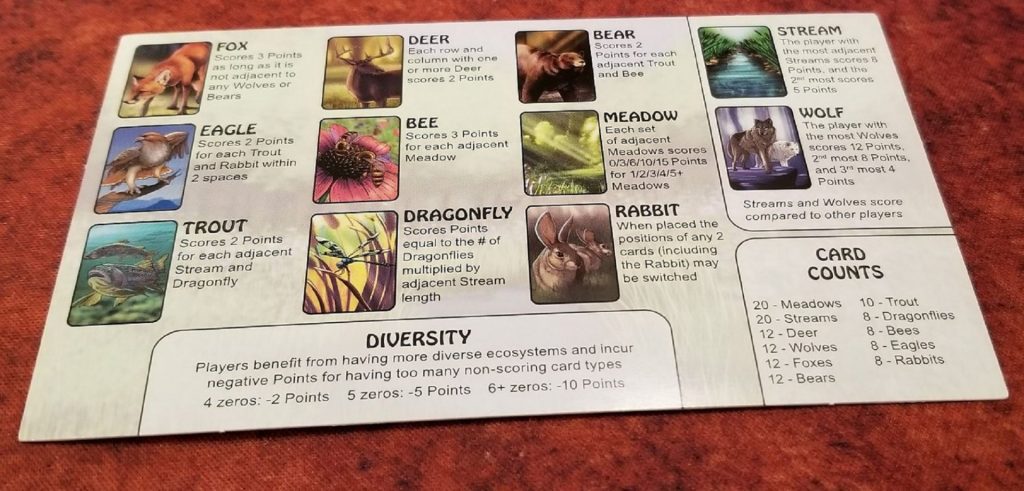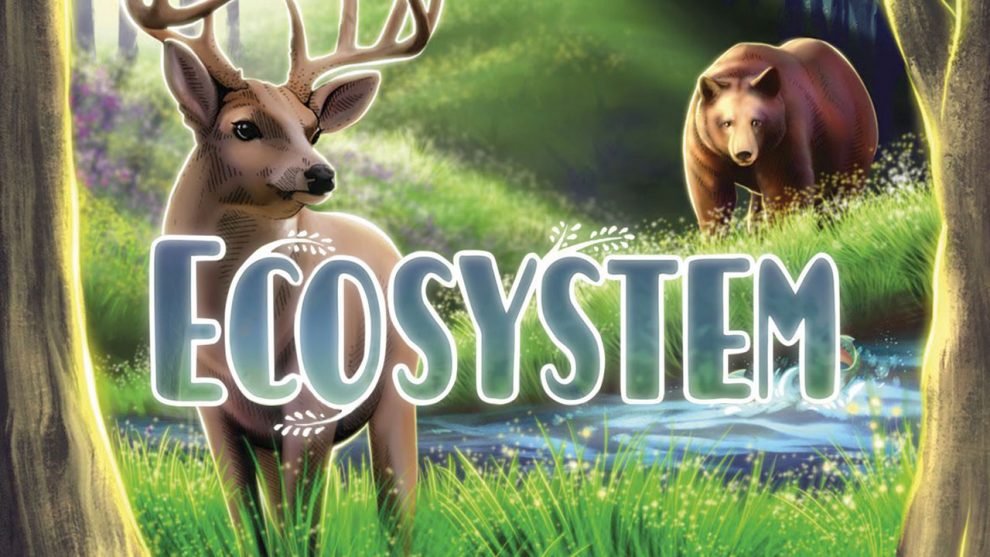Disclosure: Meeple Mountain received a free copy of this product in exchange for an honest, unbiased review. This review is not intended to be an endorsement.
Nature thrives on congruence. In a flourishing and healthy ecosystem each separate thing derives something necessary from some other thing while at the same time providing a benefit to something else. The water provides a habitat for the fish. The fish feed the bear. The bears leave refuse which nourishes the soil. The soil feeds the flowers which attract the bees… and so on. Each organism is an important part of a much larger whole. If even one variable is removed, the entire cycle collapses.
In the game of Ecosystem – a card drafting, tableau building game – players are going to be competing to construct the highest scoring ecosystem. Different cards score in different ways depending upon their spatial arrangement within the tableau. For instance, some want to be close together while others want to be certain distances apart. Once each player has constructed their 5 x 4 card-based ecosystem, they will tally up their scores on the included scorepad to determine the winner.
This is, of course, a high level overview of how the game is played. If you’d like to skip learning the game and just see what I think, then feel free to skip ahead to the Thoughts section. For the rest of you…
Setup
The set up for Ecosystem is incredibly easy. The entire deck of cards is shuffled and placed face down to form a draw pile. Then each player is given 10 cards from the top of the deck and a player aid. Once this is done, you’re ready to begin playing.
Playing the Game
Ecosystem is played over 2 rounds. The only difference between the two rounds is in the direction the cards will be passed. In round 1, the cards are passed to the left. The opposite is true for round 2. Players will be playing cards into a grid which they will be forming in front of them. This grid must consist of 5 columns and 4 rows. With the exception of the very first card placed, each card must be placed orthogonally adjacent to an existing card so long as this 5 x 4 rule is never violated.

During a round of play, the players will:
- Choose one of the cards in their hand and place it face down on top of their player aid.
- Pass the remaining cards face down to the person on the left or right depending upon the round.
- Once everyone has selected a card and passed the unchosen ones, everyone reveals the card they have selected.
- The players place the selected card into their tableau.
- Pick up the cards that were passed to them in Step 2 and begin again at Step 1.
This cycle repeats until there are no more cards to place. If this is the end of round 1, each player is dealt 10 new cards and the second round begins. If this is the end of round 2, then scoring is performed.
Scoring
There are 11 different types of cards and each one scores differently from all of the others. For instance, each Trout card in your display scores 2 points for each orthogonally adjacent Stream and Dragonfly card while Dragonfly cards score by counting the number of Dragonfly cards orthogonally adjacent to Stream cards and multiplying that by the length of the Stream. I’m not going to go into a lot of detail here regarding how each card scores. You can see for yourself on the handy player aid shown here:

Players can also incur negative points by not having enough different types of cards present in their ecosystem, so it pays to diversify. Once all of the scores have been tallied, the player with the highest score wins.
Thoughts
When I first opened the box for Ecosystem I was struck by two things: 1.) the sparsity of the contents and 2.) Ecosystem is a very attractive game. Nestled inside of the box is a rules sheet, a score pad, and a small shrink wrapped bundle of euro-sized cards featuring some gorgeous artwork by Lindsay Falsone – an illustrator with no other board game credits to her name. If her work in this game is any indication of what she is capable of, though, I have no doubt that will change in the future.
While I admired the artwork, that component sparsity gave me pause. Not only are there very few cards in the game, but they also don’t contain any information printed on them; no words, or letters, or numbers of any kind. I’m used to playing games where the cards are jam packed with all sorts of iconography and text on them – games like Lorenzo il Magnifico or Skyward – so encountering a game consisting of nothing but cards with no text on them at all immediately made me skeptical about how good the game would actually be.
And that wasn’t the only thing that gave me reservations. The double-sided rules sheet uses one side of the sheet to explain how the game is played and the other side to describe how each different type of feature scores. How could I possibly be expected to memorize all this stuff? Could this game play well without the scoring criteria printed on the cards? As it turns out, there was nothing to be worried about.
During my first game, Ecosystem seemed very simplistic and I was beginning to think that my initial misgivings had been justified. With only one or two cards laid out onto the table, the choices seemed pretty obvious. I wasn’t feeling very challenged. But as more and more cards began getting added everything changed. Selecting which cards to add and which ones to send on became agonizing. There were times when I found myself holding several cards that would work well within my tableau but, looking at what my opponents were doing, I realized I was also holding cards that would greatly benefit them as well. Should I spite draft to deny my opponents a certain card and hope that I can make the card work for me later on or do I focus on the strategy I’ve been developing?

As it turns out, Ecosystem is pretty crunchy after all. Despite its simplistic appearance, there’s a really strong game under the hood. My hesitation was entirely unwarranted. Even the concerns about there not being any text or iconography on the cards were unfounded. That player aid is a thing of beauty, finding that fine balance between looking good, being unobtrusive, and providing a ton of useful information in a user friendly fashion. So much so that after reading the rules sheet to learn how to play the game, I never had to pick it up ever again.
The only negative thing I have to comment on is that the cards are very flimsy and hard to shuffle. I imagine that using the euro-sized cards was a decision made to either save space or cut down on printing costs (or both), but it’s not a decision that I am entirely thrilled with. Since the game can play up to 6 people and each person’s tableau will be comprised of 20 cards, you’re looking at a pile of 120 tiny little cards that you’re being asked to shuffle each game. I always have to break this pile down into 3 or 4 smaller piles and then shuffle each of those before restacking them. And the flimsiness of these cards has me feeling like the game is going to start looking pretty ragged after 20 or so plays. It would just be so much simpler if they were standard sized poker cards. They’d shuffle much more easily and hold up much better.
Aside from those things I have nothing but praise for Ecosystem. It’s a fun little game that’s easy to teach, easy to set up, easy to play, and easy to put away. With a short play time of only 15-20 minutes, it’s a game that lends itself to a lot of “let’s play that again” moments. I have no doubt that if you give Ecosystem a try, you’ll experience plenty of those moments of your own.
If you try Ecosystem and find that you enjoy card drafting, then check out our card drafting step ladder to find some other card drafting games that you might enjoy!












Add Comment